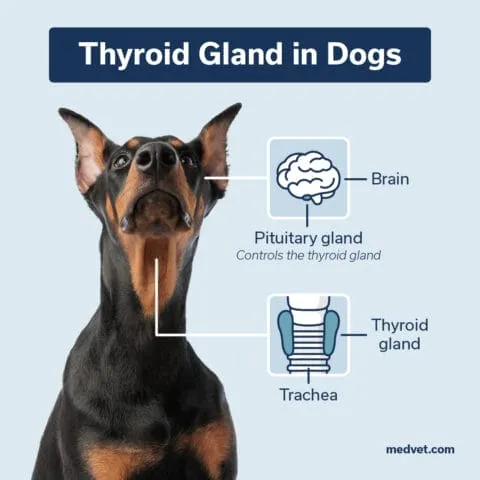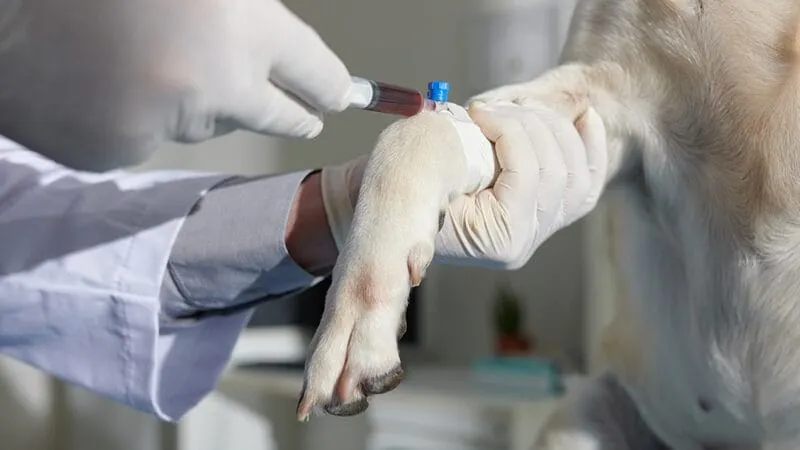The thyroid gland is a crucial endocrine organ, acting as a master regulator for many bodily functions, including metabolism, growth, and development. For many dog owners, discovering “My Dog Has A Thyroid Problem” can be concerning, yet it’s a relatively common health issue in canines. Understanding the thyroid’s role, recognizing the subtle signs of a disorder, knowing how it’s diagnosed, and exploring available treatment options can empower you to better manage your dog’s health and ensure they live a full, happy life.
What is the Thyroid Gland and Hypothyroidism in Dogs?
Located in the neck, specifically near the trachea or windpipe, the thyroid gland consists of two lobes. This vital gland operates under the control of the pituitary gland, situated at the base of the brain. The thyroid consistently releases hormones, primarily thyroxine (T4) and triiodothyronine (T3), into the bloodstream. These hormones are essential for regulating the body’s metabolism – essentially, how efficiently your dog’s cells utilize energy. Think of it as the body’s internal furnace, maintaining optimal function.
When your dog’s thyroid gland becomes diseased, this “furnace” can malfunction. The most prevalent thyroid disorder in dogs is hypothyroidism, a condition where the thyroid gland fails to produce an adequate amount of thyroid hormone. This deficiency leads to a significant slowdown in your dog’s metabolic rate. What makes hypothyroidism particularly challenging is that it can develop gradually, often without obvious signs, and by the time a diagnosis is made, a dog might have already lost up to 75% of its thyroid tissue.
 Anatomy diagram of a dog's thyroid gland located in the neck
Anatomy diagram of a dog's thyroid gland located in the neck
Recognizing the Signs: Is My Dog Showing Symptoms of a Thyroid Problem?
The symptoms of hypothyroidism in dogs can be varied and often subtle, making it difficult for owners to pinpoint without veterinary intervention. If you’re thinking “my dog has a thyroid problem,” look out for these common indicators:
- Weight Gain: A significant sign is unexplained weight gain, even if your dog’s diet and activity levels haven’t changed. Their slowed metabolism means fewer calories are burned.
- Lethargy and Decreased Activity: Affected dogs often exhibit a noticeable decrease in energy. They may seem unusually tired, sluggish, less enthusiastic about walks or play, and generally less active than usual.
- Skin and Coat Problems: Hypothyroid dogs frequently develop various [dog skin disease and treatment] issues. Their skin might appear dry, flaky, or darkened, and they could experience recurrent skin infections. The coat itself often deteriorates, becoming dull, brittle, and sparse. Hair loss is common, particularly on the flanks, thighs, neck, and tail. You might also notice that hair grows back very slowly, or not at all, after clipping.
- Cold Intolerance: Dogs with an underactive thyroid may struggle to tolerate cold temperatures. They might seek out warmer spots, shiver more, or seem uncomfortable in environments they previously handled well.
- Reproductive Issues: In female dogs, irregular heat cycles or infertility can occur. Male dogs may show a reduced libido.
- Other Less Common Signs: These can include anemia (a reduction in red blood cells), elevated blood cholesterol levels, certain neurological signs like weakness or disorientation, and a slower-than-normal heart rate (bradycardia).
What Causes Thyroid Problems in Dogs?
The exact cause of canine hypothyroidism isn’t always clear-cut. The two primary causes are:
- Lymphocytic Thyroiditis: This is an autoimmune disorder where your dog’s immune system mistakenly attacks and destroys the thyroid gland tissue. Over time, this autoimmune assault can damage enough of the thyroid to cause insufficient hormone production, leading to hypothyroidism.
- Idiopathic Thyroid Gland Atrophy: In this condition, the thyroid tissue degenerates and is replaced by fat. The underlying reason for this process is not fully understood, but it results in a similar outcome of insufficient thyroid hormone.
Hypothyroidism is more commonly seen in medium to large breed dogs and typically affects those in their middle-aged years, generally between four and ten years old. While any dog breed can be affected, some are genetically predisposed to developing “my dog has a thyroid problem” concerns. These breeds include Beagles, Borzois, Boxers, Cocker Spaniels, Doberman Pinschers, Giant Schnauzers, Golden Retrievers, Irish Setters, and Rhodesian Ridgebacks, among others. Some of these breeds may also be predisposed to [skin conditions in pitbulls] or other breed-specific dermatological issues that could overlap with or complicate the diagnosis of thyroid-related skin changes.
Diagnosing a Thyroid Condition in Your Dog
If you suspect “my dog has a thyroid problem,” a thorough diagnosis is crucial. This typically involves a combination of clinical evaluation by your veterinarian and specific diagnostic blood tests. Your vet will begin with a comprehensive physical examination and gather your dog’s medical history, paying close attention to any observed symptoms. Blood tests are essential to measure your dog’s hormone levels and confirm the diagnosis. The most common tests include:
- Total T4 (TT4): Often a preliminary screening test, TT4 measures the total amount of thyroxine in the blood. However, its levels can be influenced by other illnesses or medications your dog might be taking, meaning a low TT4 alone doesn’t always confirm hypothyroidism.
- Free T4 (FT4) by Equilibrium Dialysis: This test measures the unbound, biologically active form of T4. It’s generally considered more accurate than TT4 because it’s less affected by non-thyroidal illnesses or certain medications.
- Thyroid-Stimulating Hormone (TSH) Assay: This test measures the level of TSH, a hormone produced by the pituitary gland. In dogs with hypothyroidism, the pituitary gland often tries to overcompensate for the underactive thyroid by producing more TSH, so elevated TSH levels are a strong indicator.
- T3 and T4 Autoantibody Tests: These tests are used to detect the presence of antibodies against thyroid hormones. Positive results can help identify autoimmune thyroiditis as the underlying cause of hypothyroidism.
It’s common for a routine blood panel to include a T4 level, which might alert your veterinarian to a potential thyroid issue. However, due to external factors influencing T4, additional specialized tests are often necessary to confirm a definitive diagnosis of hypothyroidism.
Treatment Options: Managing Your Dog’s Thyroid Problem
The good news is that if “my dog has a thyroid problem” is confirmed, canine hypothyroidism is highly treatable. Treatment primarily involves lifelong hormone replacement therapy. The most common medication prescribed is FDA-approved levothyroxine, a synthetic form of thyroxine given orally.
The specific dosage and frequency of administering levothyroxine will depend on the severity of your dog’s condition and how well they respond to the therapy. Treatment is typically lifelong, meaning your dog will need to take medication daily for the rest of their life. Regular monitoring is also essential, involving periodic blood tests to ensure that optimal hormone levels are maintained and that the dosage is adjusted as needed to keep your dog healthy and symptom-free.
 Veterinarian administering medication to a dog for hypothyroidism treatment
Veterinarian administering medication to a dog for hypothyroidism treatment
Long-Term Outlook: Living with a Hypothyroid Dog
The prognosis for dogs diagnosed with hypothyroidism is generally excellent. With consistent and appropriate treatment, most dogs show remarkable improvement in their symptoms and can go on to lead normal, active lives. Key to their continued well-being are regular follow-up visits with your veterinarian. These appointments allow for monitoring of their progress, adjustment of medication dosages if necessary, and overall assessment of your dog’s health.
While hypothyroidism is not curable, it is highly manageable. Early detection and consistent treatment are paramount to effectively managing this condition, ensuring that affected dogs maintain a high quality of life. If you’ve been concerned about “my dog has a thyroid problem,” remember that with proper veterinary care, your dog can thrive.
If you suspect your dog might have hypothyroidism, it is crucial to schedule an appointment with your family veterinarian for a thorough evaluation. Your veterinarian may also recommend consulting a veterinary specialist in internal medicine for a more in-depth assessment and to discuss the most effective long-term management strategies for your pet’s unique needs.
Resources
- FDA. “Hypothyroidism in Dogs: There are FDA-Approved Drugs to Treat It.” https://www.fda.gov/animal-veterinary/animal-health-literacy/hypothyroidism-dogs-there-are-fda-approved-drugs-treat-it
- MedVet. “Hypothyroidism and Skin Changes in Dogs.” https://www.medvet.com/hypothyroidism-and-skin-changes-in-dogs/
- MedVet. “Internal Medicine.” https://www.medvet.com/specialty/internal-medicine/
- MedVet. “Pet Care Resources.” https://www.medvet.com/pet-care-resources/
